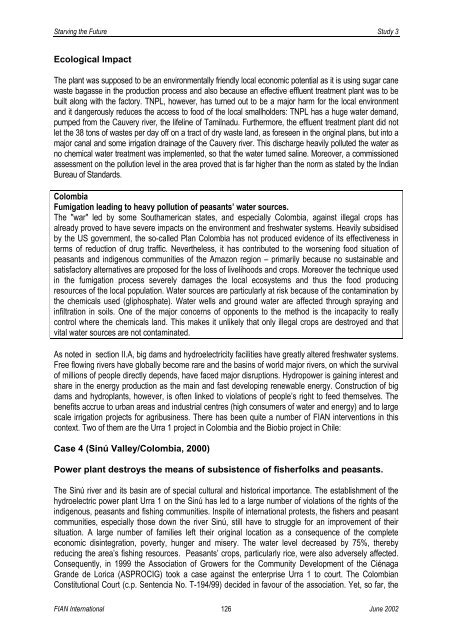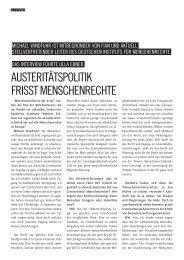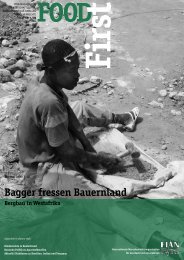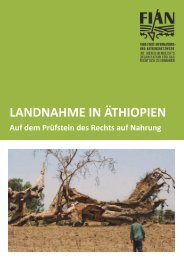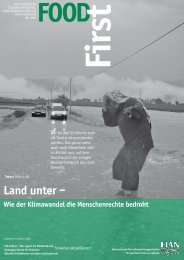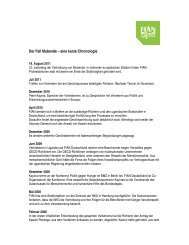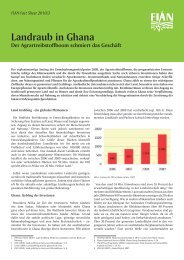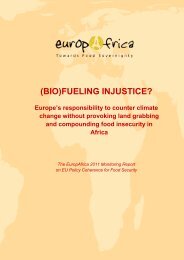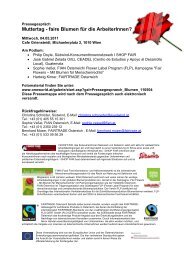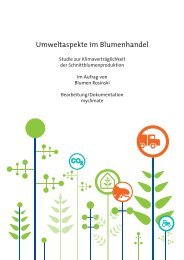Study 3: Ecodestruction and the Right to Food: The Cases of Water ...
Study 3: Ecodestruction and the Right to Food: The Cases of Water ...
Study 3: Ecodestruction and the Right to Food: The Cases of Water ...
You also want an ePaper? Increase the reach of your titles
YUMPU automatically turns print PDFs into web optimized ePapers that Google loves.
Starving <strong>the</strong> Future <strong>Study</strong> 3<br />
Ecological Impact<br />
<strong>The</strong> plant was supposed <strong>to</strong> be an environmentally friendly local economic potential as it is using sugar cane<br />
waste bagasse in <strong>the</strong> production process <strong>and</strong> also because an effective effluent treatment plant was <strong>to</strong> be<br />
built along with <strong>the</strong> fac<strong>to</strong>ry. TNPL, however, has turned out <strong>to</strong> be a major harm for <strong>the</strong> local environment<br />
<strong>and</strong> it dangerously reduces <strong>the</strong> access <strong>to</strong> food <strong>of</strong> <strong>the</strong> local smallholders: TNPL has a huge water dem<strong>and</strong>,<br />
pumped from <strong>the</strong> Cauvery river, <strong>the</strong> lifeline <strong>of</strong> Tamilnadu. Fur<strong>the</strong>rmore, <strong>the</strong> effluent treatment plant did not<br />
let <strong>the</strong> 38 <strong>to</strong>ns <strong>of</strong> wastes per day <strong>of</strong>f on a tract <strong>of</strong> dry waste l<strong>and</strong>, as foreseen in <strong>the</strong> original plans, but in<strong>to</strong> a<br />
major canal <strong>and</strong> some irrigation drainage <strong>of</strong> <strong>the</strong> Cauvery river. This discharge heavily polluted <strong>the</strong> water as<br />
no chemical water treatment was implemented, so that <strong>the</strong> water turned saline. Moreover, a commissioned<br />
assessment on <strong>the</strong> pollution level in <strong>the</strong> area proved that is far higher than <strong>the</strong> norm as stated by <strong>the</strong> Indian<br />
Bureau <strong>of</strong> St<strong>and</strong>ards.<br />
Colombia<br />
Fumigation leading <strong>to</strong> heavy pollution <strong>of</strong> peasants’ water sources.<br />
<strong>The</strong> "war" led by some Southamerican states, <strong>and</strong> especially Colombia, against illegal crops has<br />
already proved <strong>to</strong> have severe impacts on <strong>the</strong> environment <strong>and</strong> freshwater systems. Heavily subsidised<br />
by <strong>the</strong> US government, <strong>the</strong> so-called Plan Colombia has not produced evidence <strong>of</strong> its effectiveness in<br />
terms <strong>of</strong> reduction <strong>of</strong> drug traffic. Never<strong>the</strong>less, it has contributed <strong>to</strong> <strong>the</strong> worsening food situation <strong>of</strong><br />
peasants <strong>and</strong> indigenous communities <strong>of</strong> <strong>the</strong> Amazon region – primarily because no sustainable <strong>and</strong><br />
satisfac<strong>to</strong>ry alternatives are proposed for <strong>the</strong> loss <strong>of</strong> livelihoods <strong>and</strong> crops. Moreover <strong>the</strong> technique used<br />
in <strong>the</strong> fumigation process severely damages <strong>the</strong> local ecosystems <strong>and</strong> thus <strong>the</strong> food producing<br />
resources <strong>of</strong> <strong>the</strong> local population. <strong>Water</strong> sources are particularly at risk because <strong>of</strong> <strong>the</strong> contamination by<br />
<strong>the</strong> chemicals used (gliphosphate). <strong>Water</strong> wells <strong>and</strong> ground water are affected through spraying <strong>and</strong><br />
infiltration in soils. One <strong>of</strong> <strong>the</strong> major concerns <strong>of</strong> opponents <strong>to</strong> <strong>the</strong> method is <strong>the</strong> incapacity <strong>to</strong> really<br />
control where <strong>the</strong> chemicals l<strong>and</strong>. This makes it unlikely that only illegal crops are destroyed <strong>and</strong> that<br />
vital water sources are not contaminated.<br />
As noted in section II.A, big dams <strong>and</strong> hydroelectricity facilities have greatly altered freshwater systems.<br />
Free flowing rivers have globally become rare <strong>and</strong> <strong>the</strong> basins <strong>of</strong> world major rivers, on which <strong>the</strong> survival<br />
<strong>of</strong> millions <strong>of</strong> people directly depends, have faced major disruptions. Hydropower is gaining interest <strong>and</strong><br />
share in <strong>the</strong> energy production as <strong>the</strong> main <strong>and</strong> fast developing renewable energy. Construction <strong>of</strong> big<br />
dams <strong>and</strong> hydroplants, however, is <strong>of</strong>ten linked <strong>to</strong> violations <strong>of</strong> people’s right <strong>to</strong> feed <strong>the</strong>mselves. <strong>The</strong><br />
benefits accrue <strong>to</strong> urban areas <strong>and</strong> industrial centres (high consumers <strong>of</strong> water <strong>and</strong> energy) <strong>and</strong> <strong>to</strong> large<br />
scale irrigation projects for agribusiness. <strong>The</strong>re has been quite a number <strong>of</strong> FIAN interventions in this<br />
context. Two <strong>of</strong> <strong>the</strong>m are <strong>the</strong> Urra 1 project in Colombia <strong>and</strong> <strong>the</strong> Biobio project in Chile:<br />
Case 4 (Sinú Valley/Colombia, 2000)<br />
Power plant destroys <strong>the</strong> means <strong>of</strong> subsistence <strong>of</strong> fisherfolks <strong>and</strong> peasants.<br />
<strong>The</strong> Sinú river <strong>and</strong> its basin are <strong>of</strong> special cultural <strong>and</strong> his<strong>to</strong>rical importance. <strong>The</strong> establishment <strong>of</strong> <strong>the</strong><br />
hydroelectric power plant Urra 1 on <strong>the</strong> Sinú has led <strong>to</strong> a large number <strong>of</strong> violations <strong>of</strong> <strong>the</strong> rights <strong>of</strong> <strong>the</strong><br />
indigenous, peasants <strong>and</strong> fishing communities. Inspite <strong>of</strong> international protests, <strong>the</strong> fishers <strong>and</strong> peasant<br />
communities, especially those down <strong>the</strong> river Sinú, still have <strong>to</strong> struggle for an improvement <strong>of</strong> <strong>the</strong>ir<br />
situation. A large number <strong>of</strong> families left <strong>the</strong>ir original location as a consequence <strong>of</strong> <strong>the</strong> complete<br />
economic disintegration, poverty, hunger <strong>and</strong> misery. <strong>The</strong> water level decreased by 75%, <strong>the</strong>reby<br />
reducing <strong>the</strong> area’s fishing resources. Peasants’ crops, particularly rice, were also adversely affected.<br />
Consequently, in 1999 <strong>the</strong> Association <strong>of</strong> Growers for <strong>the</strong> Community Development <strong>of</strong> <strong>the</strong> Ciénaga<br />
Gr<strong>and</strong>e de Lorica (ASPROCIG) <strong>to</strong>ok a case against <strong>the</strong> enterprise Urra 1 <strong>to</strong> court. <strong>The</strong> Colombian<br />
Constitutional Court (c.p. Sentencia No. T-194/99) decided in favour <strong>of</strong> <strong>the</strong> association. Yet, so far, <strong>the</strong><br />
FIAN International 126<br />
June 2002


